| Contents [0/65] |
| Object-Oriented Design & Patterns [1/65] |
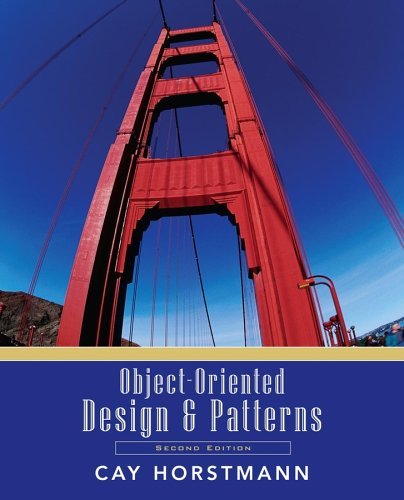
| Chapter Topics [2/65] |
| Modeling Specialization [3/65] |
| Modeling Specialization [4/65] |
| Modeling Specialization [5/65] |
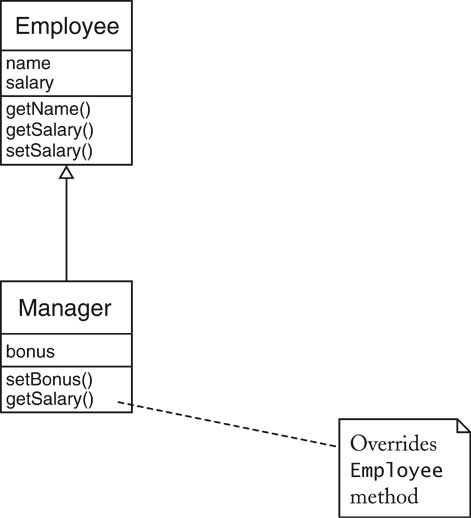
| Manager Methods and Fields [6/65] |
| The Super/Sub Terminology [7/65] |
| The Super/Sub Terminology [8/65] |
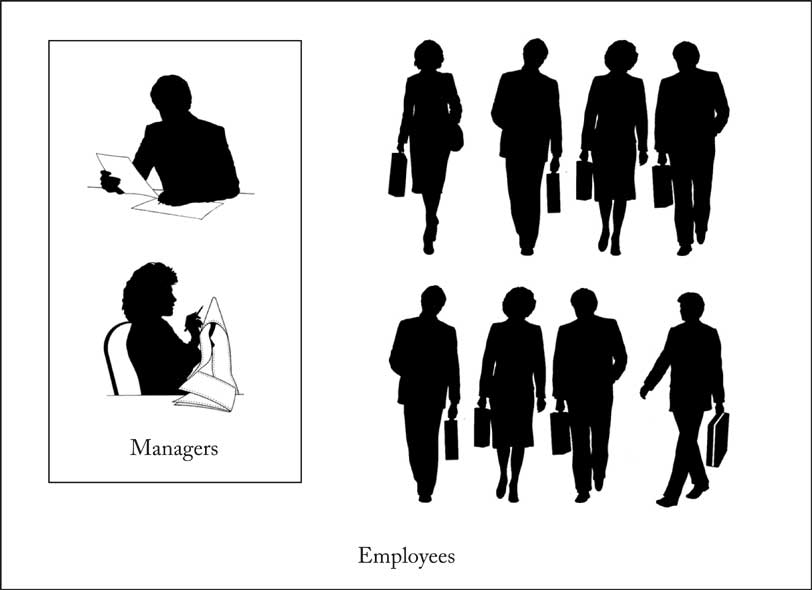
| Inheritance Hierarchies [9/65] |
| Inheritance Hierarchies [10/65] |

| The Substitution Principle [11/65] |
| Invoking Superclass Methods [12/65] |
| Invoking Superclass Methods [13/65] |
| Invoking Superclass Constructors [14/65] |
| Preconditions [15/65] |
public class Employee
{
/**
Sets the employee salary to a given value.
@param aSalary the new salary
@precondition aSalary > 0
*/
public void setSalary(double aSalary) { ... }
}
Manager m = new Manager();
Employee e = m;
e.setSalary(50000);
| Postconditions, Visibility, Exceptions [16/65] |
| Graphic Programming with Inheritance [17/65] |
| Mouse Listeners [18/65] |
public interface MouseListener
{
void mouseClicked(MouseEvent event);
void mousePressed(MouseEvent event);
void mouseReleased(MouseEvent event);
void mouseEntered(MouseEvent event);
void mouseExited(MouseEvent event);
}
public interface MouseMotionListener
{
void mouseMoved(MouseEvent event);
void mouseDragged(MouseEvent event);
}
| Mouse Adapters [19/65] |
public class MouseAdapter implements MouseListener
{
public void mouseClicked(MouseEvent event) {}
public void mousePressed(MouseEvent event) {}
public void mouseReleased(MouseEvent event) {}
public void mouseEntered(MouseEvent event) {}
public void mouseExited(MouseEvent event) {}
}
addMouseListener(new
MouseAdapter()
{
public void mousePressed(MouseEvent event)
{
mouse action goes here
}
});
| Car Mover Program [20/65] |
file:horstmann/ch06_car/CarComponent.java [source] [doc-public] [doc-private]
01
02
03
04
05
06
07
08
09
10
11
12
13
14
15
16
17
18
19
20
21
22
23
24
25
26
27
28
29
30
31
32
33
34
35
36
37
38
39
40
41
42
43
44
45
46
47
48
49
50
51
52
53
54
55
56
file:horstmann/ch06_car/CarMover.java [source] [doc-public] [doc-private]
01
02
03
04
05
06
07
08
09
10
11
12
13
14
15
16
17
18
19
20
21
22
23
file:horstmann/ch06_car/CarShape.java [source] [doc-public] [doc-private]
01
02
03
04
05
06
07
08
09
10
11
12
13
14
15
16
17
18
19
20
21
22
23
24
25
26
27
28
29
30
31
32
33
34
35
36
37
38
39
40
41
42
43
44
45
46
47
48
49
50
51
52
53
54
55
56
57
58
59
60
61
62
63
64
65
66
67
68
69
70
71
72
73
74
75
76
77
78
79
80
81
| Car Mover Program [21/65] |
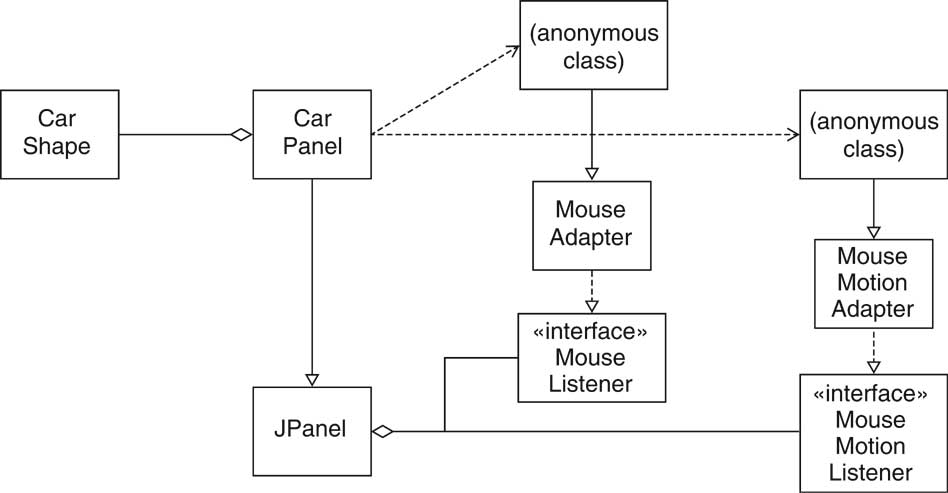
| Scene Editor [22/65] |
| Scene Editor [23/65] |
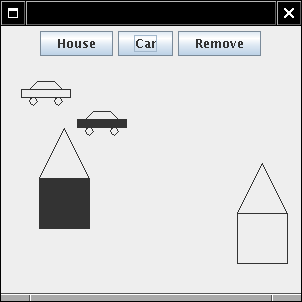
| The SceneShape Interface Type [24/65] |
| The SceneShape Interface Type [25/65] |
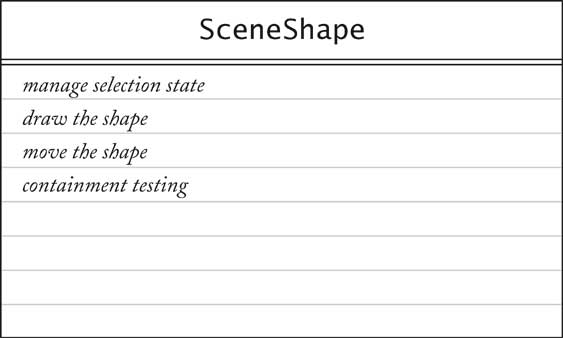
| The SceneShape Interface Type [26/65] |
public interface SceneShape
| CarShape and HouseShape Classes [27/65] |
public class CarShape implements SceneShape
{
...
public void setSelected(boolean b) { selected = b; }
public boolean isSelected() { return selected; }
private boolean selected;
}
public class HouseShape implements SceneShape
{
...
public void setSelected(boolean b) { selected = b; }
public boolean isSelected() { return selected; }
private boolean selected;
}
| Abstract Classes [28/65] |
public class SelectableShape implements Item
{
public void setSelected(boolean b) { selected = b; }
public boolean isSelected() { return selected; }
private boolean selected;
}
| Abstract Classes [29/65] |
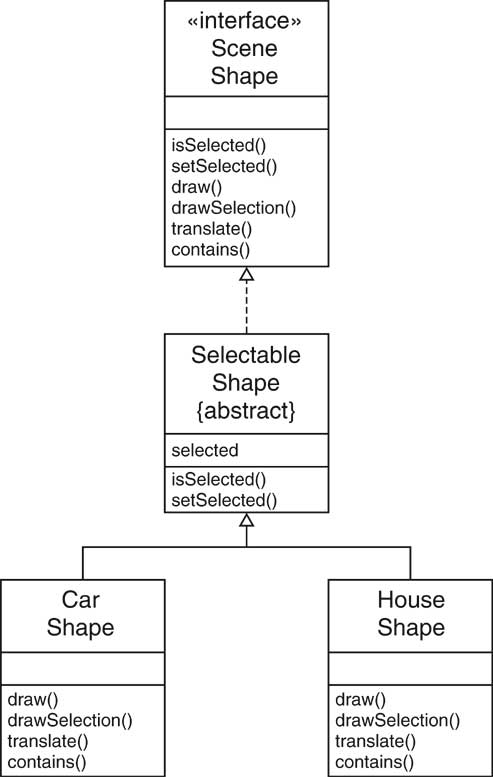
| Abstract Classes [30/65] |
SelectableShape s = new SelectableShape(); // NO
SelectableShape s = new HouseShape(); // OK
| Abstract Classes and Interface Types [31/65] |
| Scene Editor [32/65] |
file:horstmann/ch06_scene1/SceneComponent.java [source] [doc-public] [doc-private]
01
02
03
04
05
06
07
08
09
10
11
12
13
14
15
16
17
18
19
20
21
22
23
24
25
26
27
28
29
30
31
32
33
34
35
36
37
38
39
40
41
42
43
44
45
46
47
48
49
50
51
52
53
54
55
56
57
58
59
60
61
62
63
64
65
66
67
68
69
70
71
72
73
74
75
76
77
78
79
80
81
82
83
84
85
86
87
88
89
90
91
92
93
94
95
file:horstmann/ch06_scene1/SceneEditor.java [source] [doc-public] [doc-private]
01
02
03
04
05
06
07
08
09
10
11
12
13
14
15
16
17
18
19
20
21
22
23
24
25
26
27
28
29
30
31
32
33
34
35
36
37
38
39
40
41
file:horstmann/ch06_scene1/HouseShape.java [source] [doc-public] [doc-private]
01
02
03
04
05
06
07
08
09
10
11
12
13
14
15
16
17
18
19
20
21
22
23
24
25
26
27
28
29
30
31
32
33
34
35
36
37
38
39
40
41
42
43
44
45
46
47
48
49
50
51
52
53
54
55
56
57
58
59
60
61
62
63
64
65
66
67
68
69
70
71
72
| Uniform Highlighting Technique [33/65] |
| Uniform Highlighting Technique [34/65] |
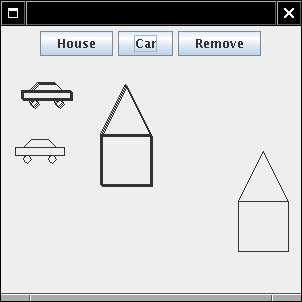
| Template Method [35/65] |
file:horstmann/ch06_scene2/SelectableShape.java [source] [doc-public] [doc-private]
01
02
03
04
05
06
07
08
09
10
11
12
13
14
15
16
17
18
19
20
21
22
23
24
25
26
27
28
29
file:horstmann/ch06_scene2/HouseShape.java [source] [doc-public] [doc-private]
01
02
03
04
05
06
07
08
09
10
11
12
13
14
15
16
17
18
19
20
21
22
23
24
25
26
27
28
29
30
31
32
33
34
35
36
37
38
39
40
41
42
43
44
45
46
47
48
49
50
51
52
53
54
55
56
57
58
59
60
61
62
63
64
65
| TEMPLATE METHOD Pattern [36/65] |
| TEMPLATE METHOD Pattern [37/65] |
| TEMPLATE METHOD Pattern [38/65] |
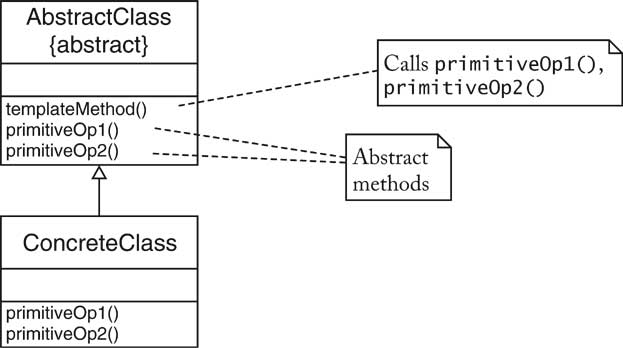
| TEMPLATE METHOD Pattern [39/65] |
| Name in
Design Pattern |
Actual Name
(Selectable shapes) |
| AbstractClass |
SelectableShape |
| ConcreteClass |
CarShape,
HouseShape |
| templateMethod() |
drawSelection |
| primitiveOp1(),
primitiveOp2() |
translate,
draw |
| Compound Shapes [40/65] |
GeneralPath path = new GeneralPath();
path.append(new Rectangle(...), false);
path.append(new Triangle(...), false);
g2.draw(path);
file:horstmann/ch06_scene3/CompoundShape.java [source] [doc-public] [doc-private]
01
02
03
04
05
06
07
08
09
10
11
12
13
14
15
16
17
18
19
20
21
22
23
24
25
26
27
28
29
30
31
32
33
34
35
36
37
38
39
40
41
42
43
44
45
46
47
file:horstmann/ch06_scene3/HouseShape.java [source] [doc-public] [doc-private]
01
02
03
04
05
06
07
08
09
10
11
12
13
14
15
16
17
18
19
20
21
22
23
24
25
26
27
28
29
30
31
32
33
34
35
36
37
38
39
40
41
| Compound Shapes [41/65] |

| Access to Superclass Features [42/65] |
public HouseShape()
{
add(new Rectangle(...));
add(new Triangle(...));
}
| Protected Access [43/65] |
| Hierarchy of Swing Components [44/65] |
int getWidth()
int getHeight()
Dimension getPreferredSize()
void setBackground(Color c)
. . .
| Hierarchy of Swing Components [45/65] |
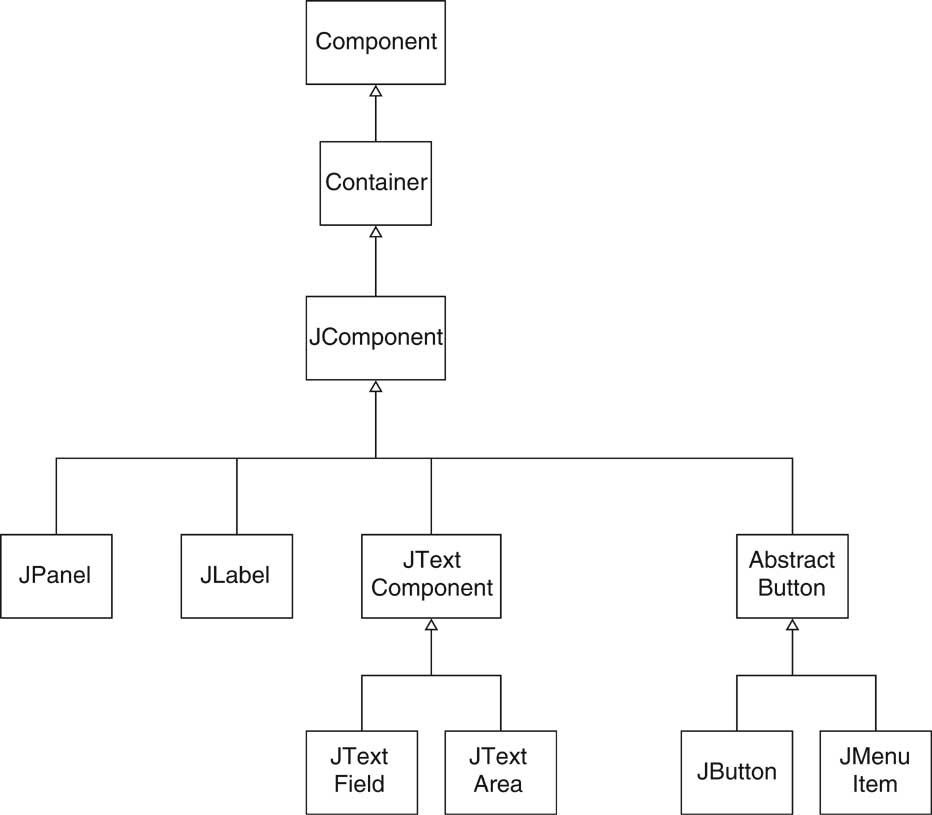
| Hierarchy of Swing Components [46/65] |
| Look and Feel [47/65] |
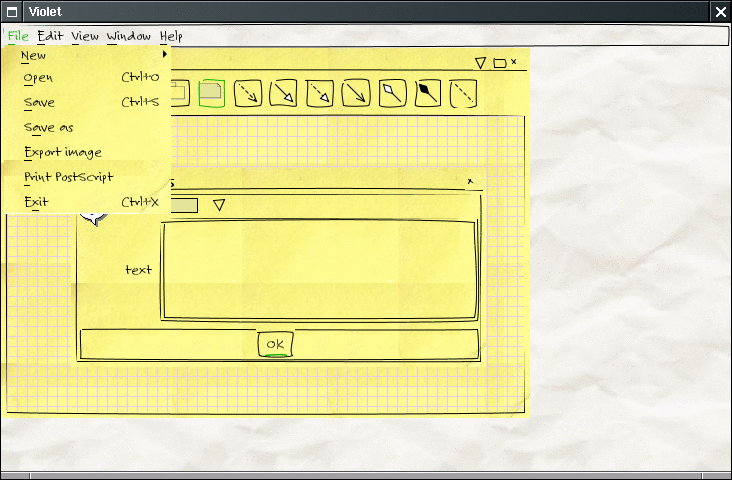
| Hierarchy of Swing Components [48/65] |
| Hierarchy of Geometrical Shapes [49/65] |
Point
Rectangle
Polygon
Point2D
Rectangle2D
RoundRectangle2D
Line2D
Ellipse2D
Arc2D
QuadCurve2D
CubicCurve2D
GeneralPath
Area
| Hierarchy of Geometrical Shapes [50/65] |
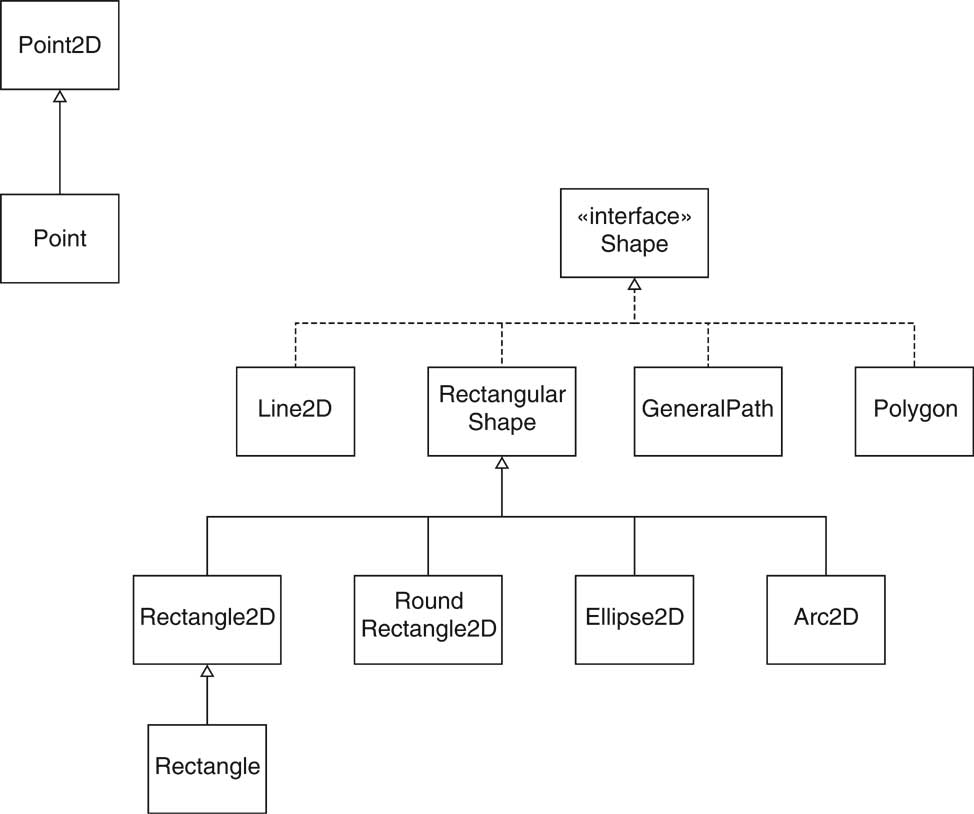
| Rectangular Shapes [51/65] |
Rectangle2D
RoundRectangle2D
Ellipse2D
Arc2D
getCenterX/getCenterY
getMinX/getMinY
getMaxX/getMaxY
getWidth/getHeight
setFrameFromCenter/setFrameFromDiagonal
| Float/Double Classes [52/65] |
Rectangle2D.Double
Rectangle2D.Float
| Float/Double Classes [53/65] |
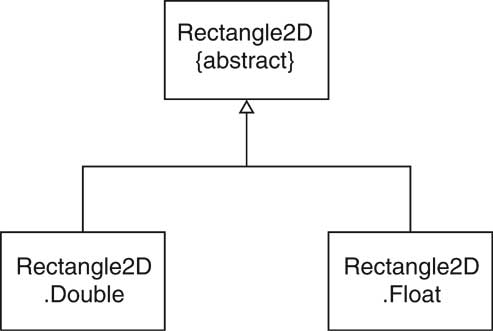
| Float/Double Classes [54/65] |
public class Rectangle2D
{
public static class Float extends Rectangle2D
{
public double getX() { return x; }
public double getY() { return y; }
public double getWidth() { return width; }
public double getHeight() { return height;}
public void setRect(float x, float y, float w, float h)
{
this.x = x; this.y = y;
this.width = w; this.height = h;
}
public void setRect(double x, double y,
double w, double h)
{
this.x = (float)x; this.y = (float)y;
this.width = (float)w; this.height = (float)h;
}
...
public float x;
public float y;
public float width;
public float height;
}
. . .
| Float/Double Classes [55/65] |
. . .
public static class Double extends Rectangle2D
public double getX() { return x; }
public double getY() { return y; }
public double getWidth() { return width; }
public double getHeight() { return height;}
public void setRect(double x, double y,
double w, double h)
{
this.x = x; this.y = y;
this.width = w; this.height = h;
}
...
public double x;
public double y;
public double width;
public double height;
}
...
}
| Float/Double Classes [56/65] |
public boolean contains(double x, double y)
{
double x0 = getX();
double y0 = getY();
return x >= x0 && y >= y0 &&
x < x0 + getWidth() &&
y < y0 + getHeight();
}
| TEMPLATE METHOD Pattern [57/65] |
| Name in
Design Pattern |
Actual Name
(Rectangles) |
| AbstractClass |
Rectangle |
| ConcreteClass |
Rectangle2D.Double |
| templateMethod() |
contains |
| primitiveOpn() |
getX, getY, getWidth, getHeight |
| Hierarchy of Exception Classes [58/65] |
| Hierarchy of Exception Classes [59/65] |
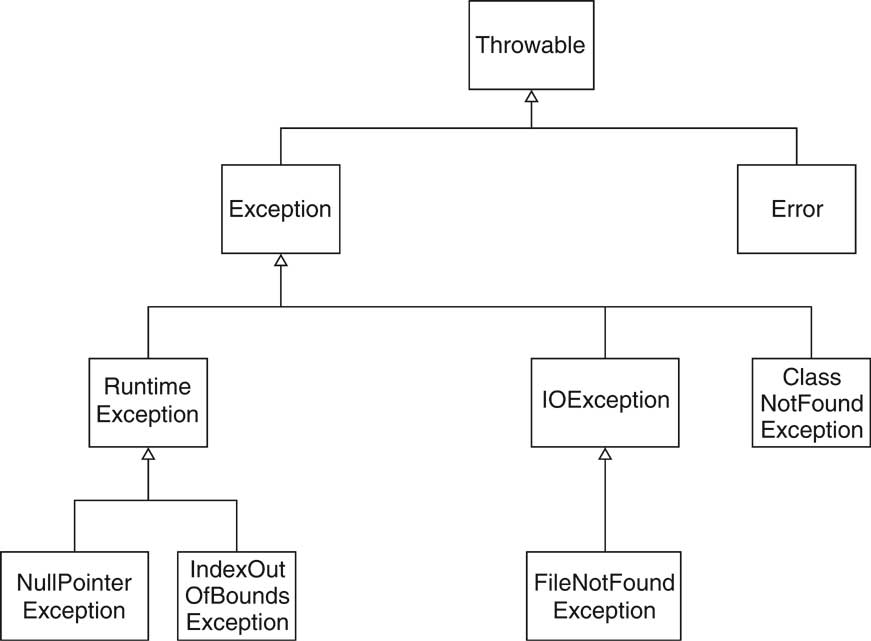
| Catching Exceptions [60/65] |
try
{
code that may throw exceptions
}
catch (ExceptionType1 exception1)
{
handler for ExceptionType1
}
catch (ExceptionType2 exception1)
{
handler for ExceptionType2
}
| Defining Exception Classes [61/65] |
public class IllegalFormatException extends Exception
{
public IllegalFormatException() {}
public IllegalFormatException(String reason)
{ super(reason); }
}
| When Not to Use Inheritance [62/65] |
public class Point
{
public Point(int anX, int aY) { ... }
public void translate(int dx, int dy) { ... }
private int x;
private int y;
}
public class Circle extends Point // DON'T
{
public Circle(Point center, int radius) { ... }
public void draw(Graphics g) { ... }
private int radius;
}
| When Not to Use Inheritance [63/65] |
public class Rectangle extends Point // DON'T
{
public Rectangle(Point corner1, Point corner2) { ... }
public void draw(Graphics g) { ... }
public void translate(int dx, int dy) { ... }
private Point other;
}
| When Not to Use Inheritance [64/65] |
public void translate(int dx, int dy)
{
super.translate(dx, dy);
other.translate(dx, dy);
}
| When Not to Use Inheritance [65/65] |
public class Stack<T> extends Vector<T> // DON'T
{
T pop() { ... }
void push(T item) { ... }
...
}
public class Stack<T>
{
...
private ArrayList<T> elements;
}
Revised: 2007/09/11 16:28